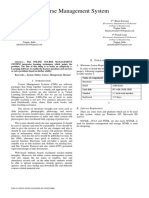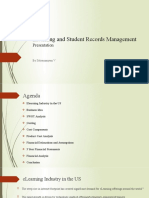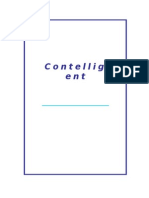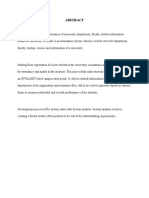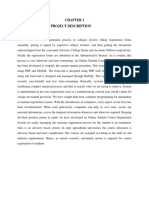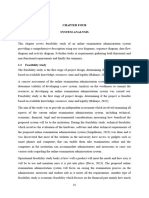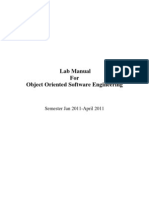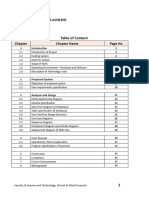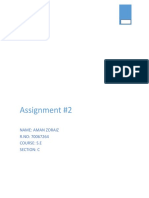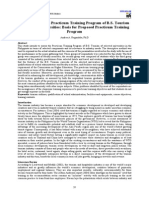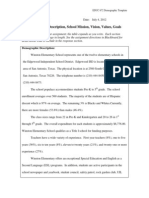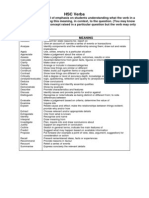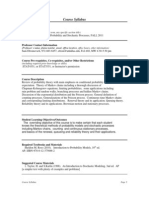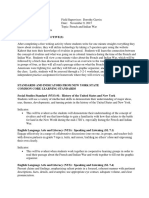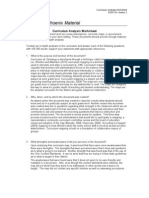Information and Knowledge Management ISSN 2224-5758 (Paper) ISSN 2224-896X (Online) Vol.3, No.
1, 2013
www.iiste.org
An e-Course file management system: A green campus initiative
Anwar M. A.1* Naseer Ahmed2 1. 2. College of Engineering and Computing, Al Ghurair University, Dubai Academic City, PO Box 37374, United Arab Emirates Institutional Research and Effectiveness, Al Ghurair University, Dubai Academic City, PO Box 37374, Dubai, United Arab Emirates * E-mail of the corresponding author: anwar@agu.ac.ae
Abstract Most accreditation agencies require academic institutions to maintain course files as an integral part of monitoring the overall quality of the educational process and to gauge how effective the course(s) have been taught and assessed at the time of offering each individual course. The paper-based course files maintained manually present a variety of disadvantages that include physical storage, retrieval issues, and recurring paper and printing costs. Moreover, the extensive paper usage required to maintain course files poses negative environmental impacts occurring during the paper making and disposal stages of paper life-cycle. As a green campus initiative, we propose a prototype eCourse file database management system to compile and organize the course files via user friendly graphical user interfaces. Keywords: Assessment items, Course file, Accreditation, Data sharing, Information retrieval 1. Introduction A portfolio can be defined as a purposeful collection of student work that tells the story of a students effort, progress and/or achievement in one or more subject areas (Arter, J. A. et al. 1992). Accreditation Board for Engineering and Technology emphasizes (ABET 2011) on the importance of assessment and defines it as one or more processes that identify, collect, and prepare data to evaluate the attainment of student outcomes and program educational objectives. This requirement could be facilitated by keeping a record of complete information along with the relevant documents used for teaching and assessing all courses taught in a given institution. A course file is a documented evidence of teaching and learning which helps us to review and improve both teaching and learning process taken place in the class. It also exhibits the strength and accomplishment of each faculty member as it includes the documents and materials that narrate the quality of his/her teaching abilities and performance. A course file is not only a collection of syllabus, assignments, and evidence of students achievements, but it should also include analysis and reflection on the failure or success of each individual course. The course file may also put forward an agenda for changing the course content, pedagogy, assessment methods and techniques in order to improve future course offerings. A careful survey shows that course files are typically maintained manually. This compilation method has many disadvantages such as limited sharing, information retrieval, physical storage, paper and printing costs, number of required man-hours, disposal of old files, wastage of natural resources, and environmental impact. In recent years, a number of universities (Sharp, L. 2002) have launched a variety of environmental sustainability programs and have achieved reasonable successes. Campus sustainability has become an issue of global concern for university policy makers and planners as result of the realization of the impacts the activities and operations of universities have on the environment (Alshuwaikhat, et al. 2008). As a part of campus sustainability programs, one can focus on improving energy efficiency, conserving resources and enhancing environmental quality by using information technology (IT) tools and resources. These efforts can certainly make a significant contribution towards healthy and sustainable environment learning environment. A number of IT solutions (such as Oracle Content Management 2009 and MS Sharepoint 2010) could facilitate organizations to devise mechanisms for creating, routing, approving, and publishing of documents which ultimately could replace paper-based documentation. The proposed green campus initiative is clearly a step in the same direction as it aims to replace or convert paper-based course files and related processes to the electronic versions. To address the above issues, we propose a database system to replace the manual record keeping of the course files. This system will facilitate instructors in organizing their course files through guided Graphical User Interfaces (GUIs). The eCourse file contents created by this new system will not only be a click away for all stakeholder interested in reviewing the course material but will also save the resources and cost in terms of money and
�Information and Knowledge Management ISSN 2224-5758 (Paper) ISSN 2224-896X (Online) Vol.3, No.1, 2013
man-hours.
www.iiste.org
Section 2 deals with the system architecture and related details of the graphical user interfaces. A detailed discussion is provided in section 3 whereas the conclusion of the paper is given in section 4. 2. Proposed system The architecture of the proposed system consists of three layers; database layer, systems module layer, GUI layer. The database layer stores the information of faculty, courses taught in a semester and the electronic versions of all course related documents such as syllabus, assignments students worked sample etc. A complete list of the items to be included in the course files prepared at our university is given in Table 1. This list is drawn from the current Standards for Licensure and Accreditation [7] mandated by the Commission for Academic Accreditation (CAA), Ministry of Higher Education and Scientific Research, United Arab Emirate. Table 1. Course file content list 1. 2. 3. 4. Copies of course syllabi for current and previous offerings of the course Copies of lecture notes/handouts used by the instructor in teaching this course Copies of supplementary material used in this course Copies of all student assessment items along with instructors worked answers and marking schemes, and the examples from across the range (excellent, average, and poor) of students performance 5. 6. 7. 8. 9. Student attendance record sheet(s) Quality review of student assessment (completed and signed) Instructor course review form (completed and signed) Copy of class results from LOGSIS (student information system) Quantitative analysis of student performance in the course
10. Summary of student feedback on the evaluation of the course The course instructor prepares all items listed above in accordance with the specified instructions and university approved templates. He/she also scans the students worked samples as required under the item number 4 of the course file list. The module layer consists of twelve modules; Syllabus Management, Answer Key Management, Assessment Item Management, Lecture Notes Management, Supplementary Material Management, Attendance Management, Quality Review Management, Instructor Review Management, Class Results Management and Student Feedback, Course File View, and Reports Generator modules. The instructor is also required to implement a specific form to ensure the quality of course assessment items. All such documents/data files are developed electronically and are kept in the database. The systems module layer facilitates in storing and retrieving all data files stored in the database. The GUI allows various users i.e. faculty, heads, curriculum committees, etc. to interact with the system and perform their specific tasks. In this paper, we restrict our discussion only to certain important GUIs of the system. Furthermore, due to the limitation of the space, the technical details of the database system are also not presented. In the following subsection, we focus on the GUIs through which an instructor interacts with the eCourse File Management System. 2.1 Graphical user interface The user interacts with the system through a specific link or screen for each of the modules through which instructor can submit or view the contents in the eCourse file. To avoid unnecessary repetition, we will not present detail of each screen except the following screens discussed below. a. The instructor logs into the system through login screen. If login is successful then course selection screen appears providing two combo boxes. From the first combo box instructor selects the semester. The second combo box then lists the courses that the instructor is teaching in the selected semester. A sample screen illustrating the
�Information and Knowledge Management ISSN 2224-5758 (Paper) ISSN 2224-896X (Online) Vol.3, No.1, 2013
utility of the course selection screen is shown in Figure 1.
www.iiste.org
Figure 1. Course Selection Screen
Figure 2. eCourse File Items Screen
b. Once the instructor submits the selection of the semester and the course for which the instructor wants to create an eCourse file, the second screen appears (see Figure 2) which provides full menu of options available to prepare and manage the eCourse file for the selected course. This screen consists of 10 buttons for uploading all items to be included in the course file. By clicking on each button the respective screen is opened which is then used to upload a particular item. c. For example, when instructor clicks on the syllabus button, the screen shown in Figure 3 opens. This screen allows the instructor to upload the course syllabi for current and previous offerings of the course as per the requirement of the Commission for Academic Accreditation (CAA), Ministry of Higher Education and Scientific Research, United Arab Emirates (CAA Standards 2011). When cursor is placed in Syllabus Current or Syllabus Previous textbox, a tooltip Double-click to view or add attachments guides the user to upload or view the required files through a dialog box by browsing files. If the current syllabus has any changes, the instructor checks a box in front of the question and writes the specific changes in a textbox provided for this purpose. This information could be quite useful when the changes in the syllabi recommended by the instructors are viewed in a report generated by the system. For example, a syllabus audit report illustrating the specific change about course learning outcomes (CLOs) is shown in Figure 4.
Figure 3. Syllabus Submission Screen
Figure 4. Syllabi Audit Report
d. The screen presented in Figure 5 appears when the instructor chooses Assessment Item button. This page is used to submit the assessment instruments such as assignments, quizzes, class tests, case studies, etc., by selecting the options available in the dropdown list in front of assessment item type box. The answer key of each item along with the marking scheme or rubric is also required to be submitted by the instructor. The scanned students worked samples from across the range of students performance in three categories i.e., excellent, average and poor, are also
�Information and Knowledge Management ISSN 2224-5758 (Paper) ISSN 2224-896X (Online) Vol.3, No.1, 2013
www.iiste.org
submitted through this screen. This particular item of the course file requires the university administration to provide scanning facilities to the instructors. Modern photo copier machines having built-in scanning features required to facilitate the instructors have been provided. The instructor can submit the files relating to each assessment item either submitting each component one by one as shown or uploading all components of the item and clicking the Submit All button. The instructor repeats this action for each of the assessment item conducted in his course.
Figure 5. Assessment Items Submission Screen There are other screens that allow the instructor to submit the students attendance record, class results, student feedback report (conducted online) and various other documents such as quality review of student assessment, instructors review which are completed and documented using the specific templates approved by the university. The instructors course review form is compiled and generated using a separate database system designed to facilitate the instructors to write instructor course reviews through guided dialog boxes. This system was designed and developed as a part of one students final graduation project (AGU 2011). 3. Discussion The authors of the paper worked out the storage space and cost for a course file in terms of money and man-hours. The size of the course file that is presently used to maintain one paper-based course file is 9cm x 29cm x 32cm (8352 cubic cm) and it may contain between 200-300 pages. According to our estimate a medium range university that offers 500 courses per academic year would require a storage space of approximately 15 cubic meters. This space would be required to house 18 file cabinets. In addition, roughly 3500 US dollars would be needed to cover the paper and printing cost of 500 course files. The estimated number of man-hours spent to prepare paper-based course files will be around 1000. For the accreditation and assessment purposes of an undergraduate degree program, the institutions generally maintain a complete record of all course files for a period of four years. Therefore, maintaining the course files of the entire program for a period of four years becomes a challenging task. As discussed earlier, disposing off these course files after a specified time frame portrays a different kind of risk as it would contribute to the environmental pollution. The high usage of paper for preparing paper-based course files also poses much greater negative impact on the environment. A recent study (Hooi, et al. 2011) reports that utilization of 800 reams of white A4 paper a month (equivalent to 1600 kg paper) would cause the emission of an estimated 5 tons of CO2/month. This analysis is certainly quite worrying and certainly reinforces our efforts towards the green campus initiative proposed in this paper. As a first-hand experience, the authors also have encountered certain level of difficulty while reviewing the paper-based course files for preparing the program effectiveness reports. It is a very challenging, time consuming, and laborious task especially when specific information is required to be retrieved. For assessment purpose, the paper-based course files can only be viewed and accessed physically from the location where the files are stored. The eCourse file management system addresses all these problems as it facilitates the task of accessing, reviewing, and
�Information and Knowledge Management ISSN 2224-5758 (Paper) ISSN 2224-896X (Online) Vol.3, No.1, 2013
retrieving specific information for the relevant stakeholders.
www.iiste.org
The proposed system would also eliminate the storage and financial costs and would reduce the man-hours spent on preparing the paper-based course files. This will reduce the burden on the natural resources which is the ultimate target of green initiatives in different types of organizations for achieving a sustainable clean environment. The system will also allow the different stakeholders to view and assess the course files from their desktops. This system would also be utilized to monitor the timely administration of the continuous assessments i.e. after a specific time a report would be generated to see how many courses quizzes or tests have been conducted in accordance with the course schedule provided in the syllabus, or to know whether a solution have been provided to the student by publishing the answer keys prepared by the instructors. The system can further be enhanced to an intelligent monitoring system. The course file review panels, local and external audit teams would benefit from the system through multiple reports generated by the system. 4. Conclusions We proposed an eCourse file management system to shift from a current method of compiling paper-based course files to a more versatile method of compiling and maintaining electronic course files. The new system offers many advantages such as ease of access, information retrieval, allaying the storage and disposal issues of paper-based files. The system also offers tremendous benefit in saving paper and printing costs, reducing the human and financial resources needed for compiling course file, minimizing the negative environmental impact, saving natural resources for future generations, and contributing towards a green sustainable environment. This system may also be utilized for monitoring the progress of courses though out the duration of course offerings. The proposed system could be enhanced to a Web-based database system allowing all input screens and forms of the system to be made online. 5. Acknowledgements The authors wish to acknowledge the support of Al Ghurair University for its support to develop and implement this system. References ABET (2011). Criteria for accrediting applied science programs (effective for reviews during the 2012-2013 accreditation cycle), Accreditation Board for Engineering and Technology (ABET), USA. AGU (2011). Student graduation project. Instructors course review database system, Al Gurair University, Dubai, United Arab Emirates. Alshuwaikhat, H.M., and Abubakar, I. (2008). An integrated approach to achieving campus sustainability: assessment of the current campus environmental management practices, Journal of Cleaner Production, 16, 1777-1785. Arter, J. A., and Spandel, V. (1992). Using portfolios of student work in instruction and assessment, Educational Measurement: Issues & Practice, 11(1), 3644. CAA (2011). Standards for licensure and accreditation, Commission for Academic Accreditation (CAA), Ministry of Higher Education and Scientific Research, United Arab Emirates. Hooi, K.K., Hassan, P., and Jami, N.A. (2011). Sustainable Education: An Assessment of Carbon Footprint at UCSI University and Proposed Green Campus Initiative Framework. 3rd International Conference on Information and Financial Engineering, Singapore, 342-347. MS Sharepoint (2010). 2012) http://sharepoint.microsoft.com/en-us/Pages/default.aspx [Online] Available: (November 20,
Oracle Content Management (2009). Go Green With Oracle Content Management. [Online] Available: http://www.oracle.com/us/products/middleware/content-management/059500.pdf (November 20, 2012) Sharp, L. (2002). Green Campuses: The Road from Little Victories to Systematic Transformation, International Journal of Sustainability in Higher Education. 3(2), 128-145.
�Information and Knowledge Management ISSN 2224-5758 (Paper) ISSN 2224-896X (Online) Vol.3, No.1, 2013
www.iiste.org
Anwar M. Abaidullah is working as Assistant Professor and Deputy Dean of College of Engineering and Computing in Al Ghurair University, UAE. He received his Doctorate of Engineering with specialization in object-oriented databases from Kyushu Institute of Technology, JAPAN in 2001. Since 2001, he has been affiliated with renowned universities in GCC and Pakistan. Naseer Ahmed is working as Director of Institutional Research and Effectiveness at Al Ghurair University, UAE. He received his PhD in Physics from Heriot Watt University, UK.
�This academic article was published by The International Institute for Science, Technology and Education (IISTE). The IISTE is a pioneer in the Open Access Publishing service based in the U.S. and Europe. The aim of the institute is Accelerating Global Knowledge Sharing. More information about the publisher can be found in the IISTEs homepage: http://www.iiste.org CALL FOR PAPERS The IISTE is currently hosting more than 30 peer-reviewed academic journals and collaborating with academic institutions around the world. Theres no deadline for submission. Prospective authors of IISTE journals can find the submission instruction on the following page: http://www.iiste.org/Journals/ The IISTE editorial team promises to the review and publish all the qualified submissions in a fast manner. All the journals articles are available online to the readers all over the world without financial, legal, or technical barriers other than those inseparable from gaining access to the internet itself. Printed version of the journals is also available upon request of readers and authors. IISTE Knowledge Sharing Partners EBSCO, Index Copernicus, Ulrich's Periodicals Directory, JournalTOCS, PKP Open Archives Harvester, Bielefeld Academic Search Engine, Elektronische Zeitschriftenbibliothek EZB, Open J-Gate, OCLC WorldCat, Universe Digtial Library , NewJour, Google Scholar
